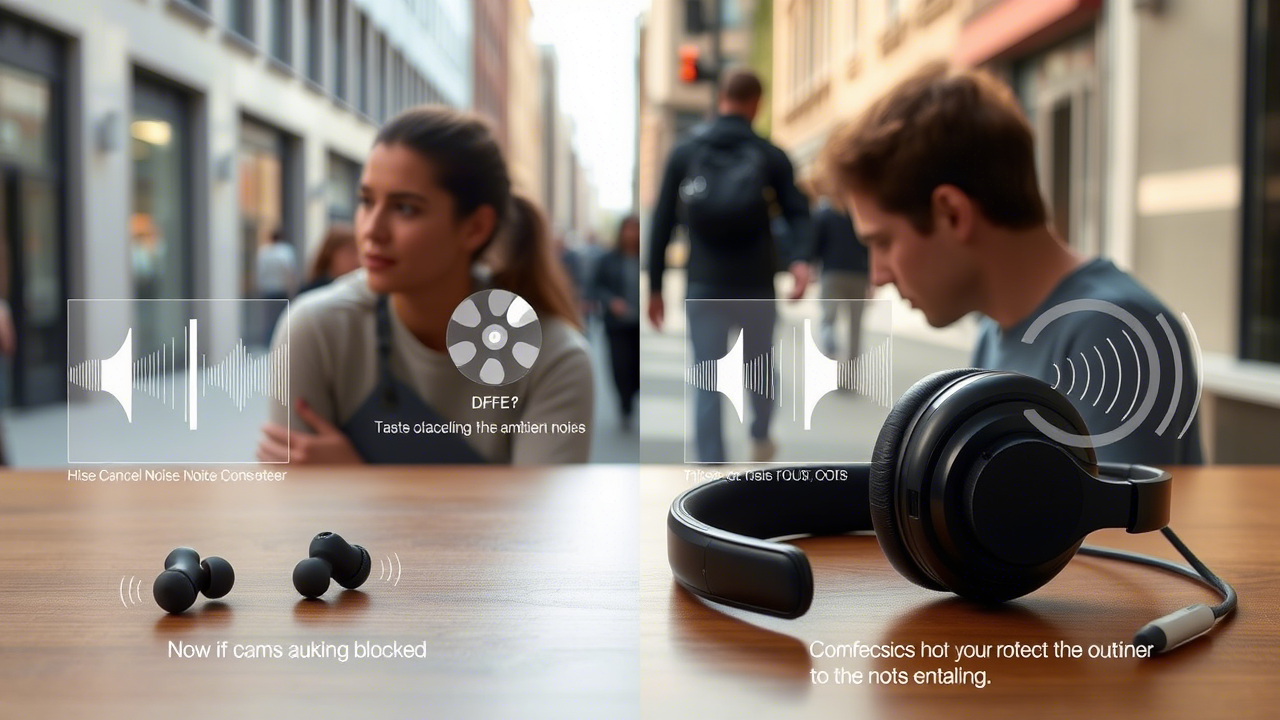Which Is Best for Noise Cancelling: Earbuds or Headphones?

Strong 8k brings an ultra-HD IPTV experience to your living room and your pocket.
The hum of a crowded café drowns out your favorite podcast. A plane’s engines rumble, stealing your focus. Noise can be a thief, robbing us of peace or productivity. That’s why choosing the right noise-cancelling device matters. Are earbuds or headphones better for noise cancelling? This question sparks debates among audio lovers everywhere.
This article dives deep into the world of noise cancellation. It compares earbuds and headphones to help you decide. We’ll explore how they work, their strengths, and what fits your life best. My own journey—toggling between earbuds for commutes and headphones for long work sessions—shapes this guide. Let’s find your perfect audio escape.
How Noise Cancelling Works
Noise cancellation is like a magic trick for your ears. It blocks out the world’s chaos so you can focus or relax. There are two types: active noise cancellation (ANC) and passive noise isolation. ANC uses technology to fight noise, while passive relies on physical barriers.
ANC works by listening to outside sounds through tiny microphones. It creates opposite sound waves to cancel them out. Think of it as noise fighting noise. Headphones like the Sony WH-1000XM5 use powerful ANC to tackle low rumbles, like airplane engines. Earbuds, like Apple AirPods Pro, also use ANC but shine with higher-pitched sounds, like voices.
Passive noise isolation is simpler. It’s about fit. Headphones block noise with cushioned ear cups, while earbuds rely on snug ear tips. A good seal is key. I learned this the hard way when my earbuds kept slipping, letting in subway chatter. For more on noise cancellation, check this full guide for noise cancelling.
Noise Cancelling in Earbuds: Pros and Cons
Earbuds are small but mighty. They slip into your pocket, making them perfect for life on the go. Their compact design is a game-changer for travelers or anyone dodging noisy commutes. I toss my Bose QuietComfort Earbuds into my bag daily, and they’ve saved me from the blare of city life.
Earbuds excel at blocking high-frequency noises, like café chatter or office hum. A tight seal from the right ear tips boosts their passive isolation. But they’re not perfect. Battery life is shorter than headphones, often lasting 5–8 hours with ANC on. Low-frequency noises, like bus engines, can sneak through. Some folks, like me, find earbuds uncomfortable after hours of wear. If the fit isn’t right, noise creeps in, ruining the effect. Still, their portability and discreet look make them a favorite for many.
Noise Cancelling in Headphones: Pros and Cons
Headphones wrap your ears in a cocoon of silence. Their larger size means stronger ANC, especially for deep sounds like airplane hums. My Sony WH-1000XM4 headphones turned a noisy flight into a quiet haven. The cushioned ear cups also provide excellent passive isolation, blocking out the world even without ANC.
But headphones have downsides. They’re bulky, making them less ideal for quick trips. Carrying them feels like lugging a small backpack. They can get warm during long use, and premium models, like Bose QuietComfort 45, cost more. Still, for home or office use, headphones often deliver unmatched sound quality and comfort. If you prioritize deep noise cancellation over portability, headphones are hard to beat.
Comparing Noise Cancelling Performance
So, which wins at noise cancelling? It depends on the noise. Headphones dominate low-frequency sounds, like traffic or plane engines, thanks to larger drivers and stronger ANC systems. A study from PMC shows headphones can reduce sound pressure levels by up to 20 dB for low frequencies. Earbuds, meanwhile, shine with high-frequency noises, like voices or keyboard clicks, when fitted properly.
In real life, this matters. On a train, my headphones block the rumble better than earbuds. But in a busy café, earbuds with a tight seal keep chatter at bay. Your environment shapes the choice. Test both in your daily routine to see what works. For a deeper dive, explore this noise cancellation guide.
Hearing Protection and Safety
Noise-cancelling devices aren’t just about focus—they protect your ears. Loud environments, like concerts or busy streets, can harm hearing over time. The World Health Organization suggests keeping sound below 80 dB for long periods. Noise cancellation lets you enjoy music at lower volumes, reducing risk.
Earbuds can be tricky. A loose fit means turning up the volume, which isn’t safe. I’ve caught myself cranking up my earbuds when they slip, letting in noise. Headphones, with their snug ear cups, often need less volume. Both are safe if used wisely, but always check your volume levels. Misconceptions about ANC causing harm lack evidence—experts say it’s safe when managed well.
Practical Considerations: Lifestyle and Use Cases
Your lifestyle decides the winner. Travelers love earbuds for their portability. I slip mine into my pocket for short flights or train rides. Headphones, though, are better for long hauls—their ANC tackles plane engines like nothing else. For exercise, earbuds stay put during runs, while headphones bounce or overheat.
At work, headphones create a focus bubble. My over-ear pair helps me tune out office chatter for hours. But earbuds are discreet for video calls or quick tasks. Transparency modes in earbuds, like those in AirPods Pro, let you hear your surroundings when needed, like crossing a busy street. Pick based on where noise bothers you most.
Cost and Value Comparison
Price is a big factor. Budget earbuds with ANC start at $50–$150, like Anker Soundcore. Premium ones, like Sony WF-1000XM5, hit $200–$300. Headphones cost more—budget options range from $100–$200, while top models like Bose QuietComfort Ultra climb to $400.
Headphones often give better ANC for the price, but earbuds win on portability. Think about value, not just cost. If you travel light, earbuds are worth it. For home use, headphones offer richer sound. Compare models within your budget to find the best fit. This guide on noise cancellation can help you decide.
Expert Tips for Choosing the Right Device
Choosing between earbuds and headphones feels personal. Test earbud fit first—try different ear tip sizes for a snug seal. A loose fit ruins ANC. For headphones, prioritize comfort if you wear them for hours. Check battery life—earbuds often lag behind headphones for long sessions.
If safety matters, pick earbuds with transparency modes for busy places. Audiophiles might prefer wired headphones for pure sound quality without ANC interference. Research brands like Bose or Sony for reliable ANC. My tip? Try both in a store to feel the difference before buying.
FAQ
What’s the difference between ANC and passive noise isolation?
Active noise cancellation (ANC) uses microphones to detect and cancel external noise with opposite sound waves. Passive isolation relies on physical barriers, like ear cups or ear tips, to block sound. ANC is better for low frequencies, while passive works well with a tight fit. Both earbuds and headphones use these methods, but headphones often have stronger ANC due to their size.
Are noise-cancelling earbuds safe for long-term use?
Yes, noise-cancelling earbuds are safe if used at moderate volumes. Keep sound below 80 dB, as recommended by WHO, to avoid hearing damage. A proper fit ensures better noise blocking, so you don’t crank the volume. Always take breaks to rest your ears during long listening sessions.
Which is better for travel: earbuds or headphones?
Earbuds are better for short trips or light packing due to their small size. Headphones excel on long flights, offering superior ANC for engine noise. Choose earbuds for convenience or headphones for deep noise cancellation, depending on your travel style.
Can noise-cancelling headphones cause auditory processing issues?
No evidence suggests noise-cancelling headphones cause auditory issues. Experts dismiss this as a myth. ANC is safe when used responsibly. Avoid high volumes, and take breaks to ensure healthy listening. Both headphones and earbuds are designed with user safety in mind.
How do I know if my earbuds fit well for noise cancellation?
A good fit feels snug without discomfort. Test different ear tip sizes to find a tight seal. If external noise creeps in, the fit is off. A proper seal boosts passive isolation and ANC, making earbuds more effective at blocking sound.
Conclusion
Earbuds and headphones both offer noise-cancelling magic, but they shine in different ways. Earbuds are portable and discreet, perfect for commutes or workouts. Headphones deliver powerful ANC for low rumbles, ideal for flights or focused work. Your choice hinges on lifestyle—travelers may lean toward earbuds, while home users might pick headphones for comfort and sound quality.
Think about your daily needs. Do you need something light or a device that blocks deep noise? Test fits and compare models to find your fit. Share your thoughts or experiences in the comments below, or explore top picks in this noise cancellation guide to make your choice.
Note: IndiBlogHub features both user-submitted and editorial content. We do not verify third-party contributions. Read our Disclaimer and Privacy Policyfor details.


